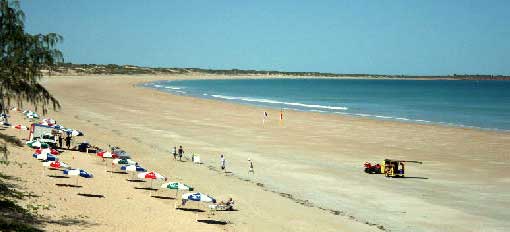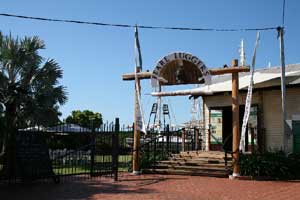 Accommodation | International
Flights | Domestic
Flights | Tours
| Travel
Insurance | Car
Hire | Visas
| Shopping
| Dating
| Humour
Accommodation | International
Flights | Domestic
Flights | Tours
| Travel
Insurance | Car
Hire | Visas
| Shopping
| Dating
| HumourAbout Broome - Accommodation - Tours and what to do - Transport and car hire - Photos - Map
Broome
Famous Cable Beach stretching for miles around
Broome
Photo by Katrin Holmsten
Broome has transformed from a small isolated outback frontier town to a more modern resort town and holiday playground. Its location is quite remote, about 2200 km. from Perth and about 1500 km. from Darwin. Main attractions are Cable Beach, the town's colorful history, and nearby attractions like Windjana Gorge and other wilderness areas accessible by four wheel drive.
One of the first Europeans to visit the area was
William Dampier in September 1700. He sailed around the WA coast
in his ship the Roebuck and came ashore somewhere in the Broome
area to look for fresh water, he did not find anything and killed
an Aborigine at the same time, a pretty unsuccesful landing alltogether.
The first attempt to settle the Broome area was a sheep grazing
venture in the 1860s, followed by the establishment of some temporary
pearling facilities in Roebuck Bay in the 1870s and the town later
kicked off as a base for the pearl divers. In 1883 the W.A. SurveyorGeneral
named it after Sir Frederick Broome, the Governor of W.A. at the
time, but the Governor was not at all amused with the shanty town
with a few tents and itinerants bearing his name.
In 1890 the settlement got a boost when the submarine telegraph
cable was routed through Broome and the Cable House, which is now
the Courthouse, was built for the telegraphists.
The entire building was shipped in from overseas and had to be carted
a long way over the mudflats because the town did not yet have a
wharf.
A few years later, thanks to the growing pearl industry and the
new port facilities utilized by cattle stations further inland,
the town now started happening and shops opened and the Roebuck
Bay Hotel was built. The population of the town was a wild combination
of Europeans, Filipinos, Malaysians, Chinese, Japanese and Aborigines.
Over the years they have mixed further and now the local population
is an interesting blend and you can see some very interesting looking
people here.

Photo by Katrin Holmsten
In the early days of the pearling industry it was
a very tough business. Before diving equipment became available
in 1887 people had to dive and collect pearls until they ran out
of breath and had to resurface. Local Aborigines were kidnapped
and forced to work as divers. Japanese divers became the main workforce
because of their amazing ability to dive deeper and longer than
others.
Many hundreds of young Japanese divers died in the process, either
from the bends, from drowning, or from sharks that were common in
the area at the time. In the early 1900s the industry was at its
peak when at least 400 pearling luggers worked out of Broome.
Thousands of Asian divers lived in the town and a lively booming
Chinatown catered for them with bars, restaurants, gambling dens
and brothels. This booming industry crashed in 1914 when World War
1 broke out and overseas clients were no longer buying pearls. It
took the industry a very long time to recover after the war, and
it was mainly the Japanese that now ran the business, but when the
pearling had finally recovered to 50 pearl luggers in 1939 yet another
war broke out.
This time the war was with Japan and so all of the Japanese population
of Broome was locked up in camps, which once again wiped out the
pearl industry. Most of Broome was evacuated in 1942 when it was
feared the Japanese army might invade the coast.
Broome is one of the very few places in Australia to have been under
attack by a foreign force, in March 1942 nine Japanese Zero fighters
bombed and destroyed 16 flying boats and 7 aircraft on Broome airstrip,
an estimated 70 people were killed in this first raid. A second
one happened later that same month, with less damage. The wrecks
of some of the flying boats can still be spotted during very low
tide in Roebuck Bay.
The pearling industry was revived again after World War 2 but this
time a bit more high tech with cultured pearls. Mid 1950s a cultured
pearl consortium became established and by the 1980s it was earning
Broome over $50 million annually.
HOME PAGE
Tourist Information
General Information
And Entertainment
ACCOMMODATION IN AUSTRALIA
Bed
& Breakfast
Budget
Accommodation
Backpackers Hostels
Hotels
in Australia
CAR HIRE IN AUSTRALIA
Australia Rental Cars
And
Campervans

TOURS
IN AUSTRALIA
What To Do In Australia
On-line
Shopping
On-line
Dating
![]()
About
Australia
Visas For Australia
How
To Get To Australia
How To Get Around
Travel Insurance
Travel Guides
Working
In Australia
Australian
Posters
Survival
Tips
Weather,
When To Go

Use of
this website constitutes acceptance of the User Agreement for this website
Contact us |
Advertise on this site
| Link to this site |Add
your photos or stories to this site |
Webmasters | Affiliates

